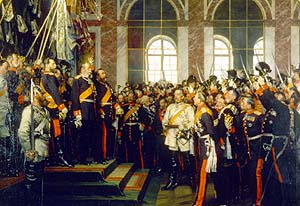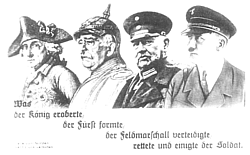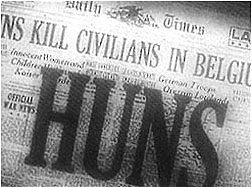| 1945
US Army film Here is Germany (back to
top)
- starts with about 3:30 minutes of footage of good, clean, wholesome
Germans
- country: "historic," "prosperous," "modern"
- people: "clean and tidy," "educated," "musical,"
"industrious"
- mailman, farmer, cop: just like the folks back home?
- They look like the kind of people we can understand -- or can
we?
- a kindly people, accept blood purges, pogroms, concentration camps
- a gentle people, fond of kids, music, tyranny, aggression, gas
chambers
- cut to 3 mins. of footage of Nazi atrocities
footage from liberated camps, massacre of Italians, Belgians, US POWs
at Malmedy
- Puzzle: how to explain the contrast between the "clean, industrious
people" and these horrors?
- Let's look deeper into the German character: What makes Germans
so?
- Germans/Hitler would answer "in their blood,"
- but Americans don't think so--we say it's in traditions
- The "bad" tradition is ascribed to Prussia: "goose-stepping
back to soldiers fought by your grandfather" in the 1870s
- allegorical common soldier "Carl Schmidt" is used to
personify the German enemy
- Nazis, Huns, Prussians: different names for three generations
of Germans
- Frederick William I, "Soldier King" of Prussia, 1713-40
- Frederick "the Great," 1740-1786: footage of men on
horseback taking prisoners
11:40: "I begin by taking. I shall find scholars
afterwards to demonstrate my perfect right."
- For 7 years he fought agains Austria, Russia, Sweden and France,
was invincible
- Legacy lived on:
- Scharnhorst & Gneisenau established the General Staff
- Clausewitz, in his book Vom Kriege (About War): "Just
as Prussia has been fated to be the core of Germany, so Germany
will be the core of the future German empire of the west."
- "Conquered people should be left with nothing but their
eyes to weep with."
- "3 pillars of power:" militarists, large landowners,
state officials
- 1806-1819: dissolution of "first Reich" by Napoleon
- historians call this the forced modernization of the state administration
(bureaucracy), education, and army
- "E pluribus unum" [out of many, one]: German states move
towards economic union
- 1848: popular revolution; but unification "from below" fails
- Heinrich Gagern and Fredrick William IV (*1795; 1840-1858; d. 1861)
- 14:10: "Never may a scrap of paper come between
me and my subjects!"
- Over the next 30 years 2 million people emigrated to the US
- "Those remaining were molded into mindless automatons."
- Otto von Bismarck (1815-1898)
- 1862 head of Prussian cabinet
- "Great questions of the day will not be decided by majorities,
but by iron and blood."
- "As soon as anybody can show me that it is sound policy, I
shall be equally satisfied to see our troops fire at the French or
the Russians, the English or the Austrians."
[professor's note: this sounds like a justification for NOT starting
a war with them!]
- 1866-1871: In three wars (against Denmark, Austria, and France)
Bismarck creates the "second Reich" "from above"

- 17:30: The Prussian king is crowned German emperor.
- "Germany's symbol is Victoria (shown atop the Brandenburg gate),
NOT the liberty bell, NOT the magna carta, NOT liberté, egalité,
fraternité."
- "The myth of Prussian superiority became the myth of the master
race."
- industrialists="4th pillar" of power
- military-industrial complex with footage of railroads, the fleet
and steel production
- Germany is rich and prosperous, the world forgot the tradition of
war and conquest
- William II succeeds William I in 1888
- is vain and arrogant

1890:
William II drops "pilot" Bismarck (famous cartoon
in satirical magazine Punch |
- fires Bismarck in 1890, making war inevitable
- 23 minutes into film: reenactment of assassination
of Austrian archduke in Sarajevo, July 1914
- Great War (World War I) starts with great fervor
- the US feels compelled to enter the war: tanks, trenches
- surrender and armistice, celebrating and fraternization among soldiers
- Was this a reason of optimism??
- ... under the surface they stayed the same, same teachers, same
general staff
- "Carl Schmidt" never saw an occupying army, but rather
an armistice instead of an unconditional surrender.
Why should he accept the shameful treaty of Versailles?
He blamed the men who signed the peace treaty.
Footage of demobilization under the terms of the treaty
- The film goes on to ask how Germany was able to rearm so quickly under
the cycle of hyperinflation and depression. An unholy quartett of:
- militarists, state officials, industrialists, and landowners
- to which Hitler added a fifth: gangsters [35 mins]
- the film runs through the Nazi period, then after about 47
minutes begins the conclusion:
- How to ensure that it won't happen again?
Unconditional surrender, removal of general staff, occupying armies,
new state officials, new textbooks made in the US
- We come as conquerers, not liberators
- Germany must rid itself of the tradition of Frederick, Bismarck
- only then can a cultured Germany join the peaceful nations of
the world
- ends to the strains of Beethoven's "Ode to Joy"
|




